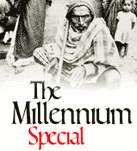The editor on the biggest stars in Hindi filmdom
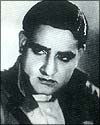 Kundan Lal Saigal: As the love-lorn alcoholic in P C Barua's classic Devdas, he gave Hindi cinema its first cult figure. People flocked to the theatre again and again to moan over the man and his velvety voice. His style of singing not only became a rage, but spawned several imitators. The early Mukesh and Kishore Kumar modeled themselves on Saigal.
Kundan Lal Saigal: As the love-lorn alcoholic in P C Barua's classic Devdas, he gave Hindi cinema its first cult figure. People flocked to the theatre again and again to moan over the man and his velvety voice. His style of singing not only became a rage, but spawned several imitators. The early Mukesh and Kishore Kumar modeled themselves on Saigal.
 Ashok Kumar: He was among the most sought-after stars of his time. A natural actor, he stood out at a time when theatricality was the order of the day. His Kismet, which broke all box office records of the previous three decades, brought into vogue the slick crime-thriller. After an impressive stint as hero, Ashok Kumar switched over to character roles in the late 1950s with unrivalled grace, and gave some memorable performance in films like Ek Hi Raasta, Baadbaan, Gumrah and Mamta.
Ashok Kumar: He was among the most sought-after stars of his time. A natural actor, he stood out at a time when theatricality was the order of the day. His Kismet, which broke all box office records of the previous three decades, brought into vogue the slick crime-thriller. After an impressive stint as hero, Ashok Kumar switched over to character roles in the late 1950s with unrivalled grace, and gave some memorable performance in films like Ek Hi Raasta, Baadbaan, Gumrah and Mamta.
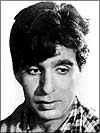 Dilip Kumar: He was a rage in the 1950s and 1960s. He set the standard for acting in Indian cinema. Four generations of actors from Rajendra Kumar to Manoj Kumar to Amitabh Bachchan to Shah Rukh Khan have been heavily influenced by him. His range and depth allowed him to switch effortlessly from a tragic Devdas to a cavalier Azad. He has done practically every kind of role under the sun.
Dilip Kumar: He was a rage in the 1950s and 1960s. He set the standard for acting in Indian cinema. Four generations of actors from Rajendra Kumar to Manoj Kumar to Amitabh Bachchan to Shah Rukh Khan have been heavily influenced by him. His range and depth allowed him to switch effortlessly from a tragic Devdas to a cavalier Azad. He has done practically every kind of role under the sun.
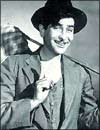 Raj Kapoor: He was the ultimate show man. An all-time great director. Though he had started out as an actor of great potential, his achievements behind the camera as director tended to undermine the performer in him. His pairing with Nargis, which resulted in films like Andaaz, Aag, Barsaat, Awara and Chori Chori, became legendary. He continued to make films till the end without resorting to big stars of the time.
Raj Kapoor: He was the ultimate show man. An all-time great director. Though he had started out as an actor of great potential, his achievements behind the camera as director tended to undermine the performer in him. His pairing with Nargis, which resulted in films like Andaaz, Aag, Barsaat, Awara and Chori Chori, became legendary. He continued to make films till the end without resorting to big stars of the time.
 Dev Anand: His is a triumph of style. As the city-smart dandy, he was absolutely outstanding in his earlier films. Though he's often derided as an actor who never acted, he has an interesting body of work including films like Guide, Jaal, Baazi, Him Dono, Baadbaan, Kala Pani, Jewel Thief and a number of frothy romantic musicals and thrillers. For almost five decades he has continued to fascinate his fans with his never-say-die spirit and flamboyance. He is one actor for whom time has had the courtesy to stand still.
Dev Anand: His is a triumph of style. As the city-smart dandy, he was absolutely outstanding in his earlier films. Though he's often derided as an actor who never acted, he has an interesting body of work including films like Guide, Jaal, Baazi, Him Dono, Baadbaan, Kala Pani, Jewel Thief and a number of frothy romantic musicals and thrillers. For almost five decades he has continued to fascinate his fans with his never-say-die spirit and flamboyance. He is one actor for whom time has had the courtesy to stand still.
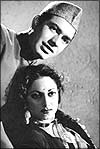 Suraiya: A singing sensation of her time, she was the first female star. No one has been able to emulate her. In the late 1940s and the early 1950s her popularity touched such a high that people waited for hours on the road to see her drive down from Marine Drive to the HMV studio on Veer Nariman Road in Mumbai. She made a great romantic team with Dev Anand in films like Sanam, Afsar, Nili and Jeet.
Suraiya: A singing sensation of her time, she was the first female star. No one has been able to emulate her. In the late 1940s and the early 1950s her popularity touched such a high that people waited for hours on the road to see her drive down from Marine Drive to the HMV studio on Veer Nariman Road in Mumbai. She made a great romantic team with Dev Anand in films like Sanam, Afsar, Nili and Jeet.
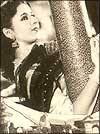 Geeta Bali: She was the first natural. The earliest tomboy among the actresses. Earthy, effervescent and uninhibited, she shed coyness and simpering so characteristic of the early Hindi film heroine. She proved her calibre and range as an actress in her very first film, Suhaag Raat, and followed it up with impressive performances in Bawre Nain, Baazi, Jaal and Albela. Geeta has inspired four generations of actresses.
Geeta Bali: She was the first natural. The earliest tomboy among the actresses. Earthy, effervescent and uninhibited, she shed coyness and simpering so characteristic of the early Hindi film heroine. She proved her calibre and range as an actress in her very first film, Suhaag Raat, and followed it up with impressive performances in Bawre Nain, Baazi, Jaal and Albela. Geeta has inspired four generations of actresses.
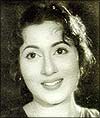 Madhubala: Acknowledged as the Venus of Indian cinema, Madhubala symbolised ultimate beauty. Which in a way undermined her merit as an actress. She imparted a lot of sizzle and impishness to her performances in films like Chalti Ka Naam Gadi. Her role as Anarkali in K Asif's Mughal-e-Azam is unforgettable.
Madhubala: Acknowledged as the Venus of Indian cinema, Madhubala symbolised ultimate beauty. Which in a way undermined her merit as an actress. She imparted a lot of sizzle and impishness to her performances in films like Chalti Ka Naam Gadi. Her role as Anarkali in K Asif's Mughal-e-Azam is unforgettable.
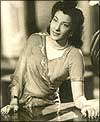 Nargis: She was immortalised by the quintessential Indian woman she played in Mehboob Khan's classic Mother India. In most of her earlier films she symbolised the modern, liberated woman, which her off-screen personality reflected. She was among the earliest actresses to bring an element of naturalness to film-acting. With Raj Kapoor she formed a legendary team.
Nargis: She was immortalised by the quintessential Indian woman she played in Mehboob Khan's classic Mother India. In most of her earlier films she symbolised the modern, liberated woman, which her off-screen personality reflected. She was among the earliest actresses to bring an element of naturalness to film-acting. With Raj Kapoor she formed a legendary team.
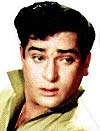 Shammi Kapoor: He was an original. And a natural. He broke the mould of the Hindi film hero, gave him am erotic presence, revolutionised the love scene and invested the song-and-dance-routine with a dynamism and exuberance which was highly individualistic. In the process, he helped evolve a new genre of popular cinema -- the romantic musical -- as exemplified in Tumsa Nahin Dekha, which continues to hold centrestage even today.
Shammi Kapoor: He was an original. And a natural. He broke the mould of the Hindi film hero, gave him am erotic presence, revolutionised the love scene and invested the song-and-dance-routine with a dynamism and exuberance which was highly individualistic. In the process, he helped evolve a new genre of popular cinema -- the romantic musical -- as exemplified in Tumsa Nahin Dekha, which continues to hold centrestage even today.
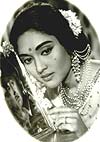 Vyjayantimala: The first South Indian heroine to cause a sensation in Mumbai's showbiz. She set the standard for the dancer-heroine. Hema and later Jaya Prada and Sridevi followed in her footsteps. Her strength essentially was her striking screen presence. But when challenged by directors of the calibre of B R Chopra (Sadhana), Bimal Roy (Devdas) and Raj Kapoor (Sangam) she came up with creditable performances.
Vyjayantimala: The first South Indian heroine to cause a sensation in Mumbai's showbiz. She set the standard for the dancer-heroine. Hema and later Jaya Prada and Sridevi followed in her footsteps. Her strength essentially was her striking screen presence. But when challenged by directors of the calibre of B R Chopra (Sadhana), Bimal Roy (Devdas) and Raj Kapoor (Sangam) she came up with creditable performances.
From Rajesh Khanna to Kajol: Rauf Ahmed's list continues tomorrow
Hema Malini's reign at the top was unrivalled
Tell us what you think of this list
